Book now
So much to see and so little time! Spend the night in Bruges or take a guided tour.
How and where to park your car in Bruges.
Are you planning a trip to Bruges and wondering how and where to park your car? Finding a parking spot in a city can be a daunting task, but with a little bit of knowledge, it can be a breeze. This guide will discuss the various options for parking in Bruges, including on-street parking, off-street parking, and special arrangements for specific needs. By the end of this guide, you will have a better understanding of where and how to park your car in Bruges, making your trip stress-free and enjoyable.
In Bruges, there are several options for parking your car, including on-street parking and off-street parking. On-street parking is regulated and restricted in certain areas and requires payment through a zone system. Off-street parking is available in the form of parking garages and lots, with varying locations and prices. With a little research, finding a parking spot that suits your needs and budget in Bruges is possible.
Short of time to read the whole article? Go directly to your favorite topic via the table of contents.
On-street parking
Regulations and restrictions:
When it comes to on-street parking in Bruges, it is important to be aware of the regulations and restrictions that are in place. The city operates a zone system, with different areas designated for different types of parking.
For the correct and up-to-date information, you can visit the official page for on-street parking in Bruges
It’s important to pay attention to the signs and parking meters in each zone, as they will indicate the specific regulations and restrictions that apply in that area. Additionally, there are certain streets and areas where parking is prohibited altogether, such as in front of schools during school hours and in front of emergency vehicle access. Violating these regulations can result in fines, so it’s important to familiarize yourself with the rules before parking your car. It’s also important to note that parking regulations and restrictions may be different during certain events or holidays.
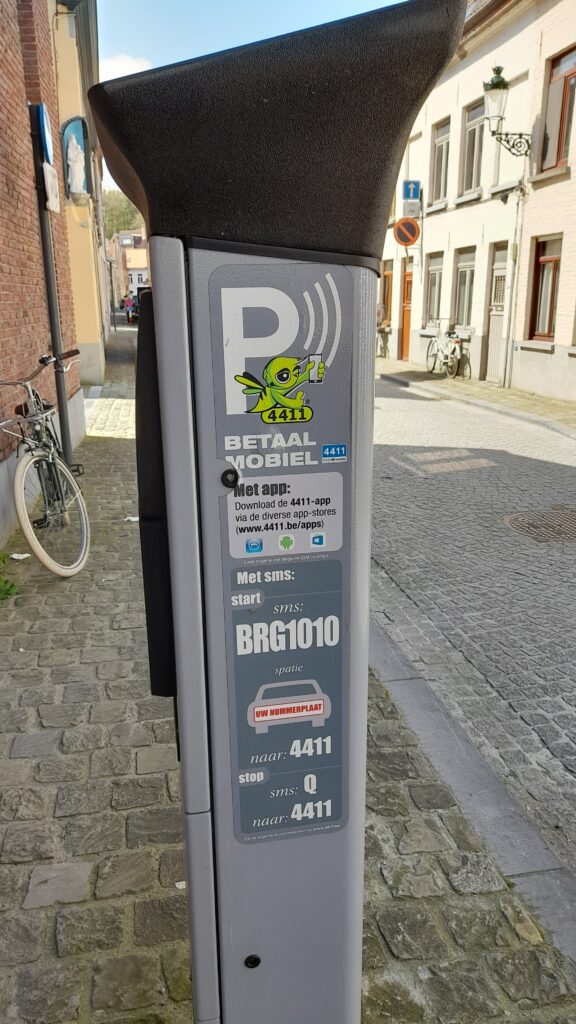
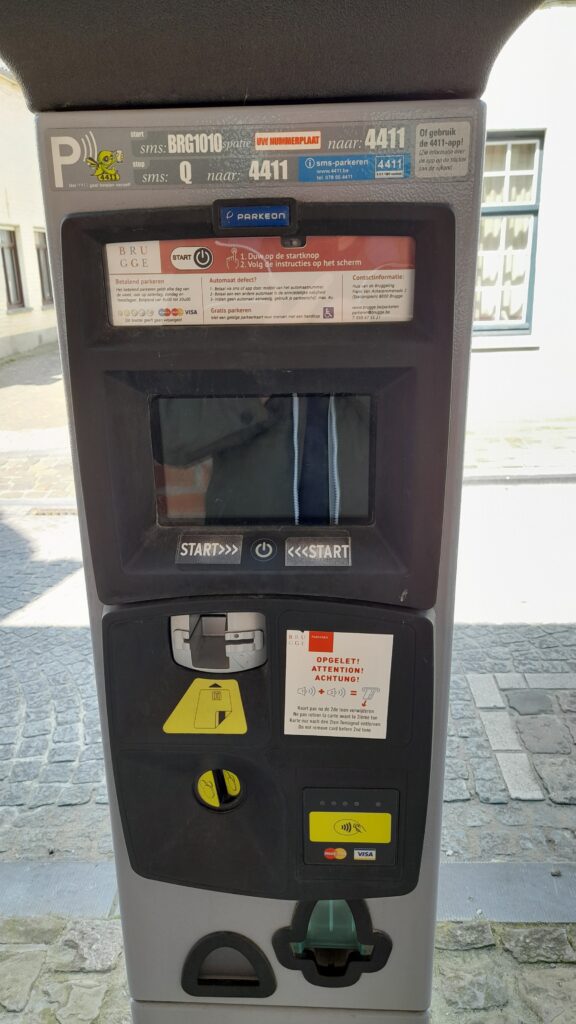

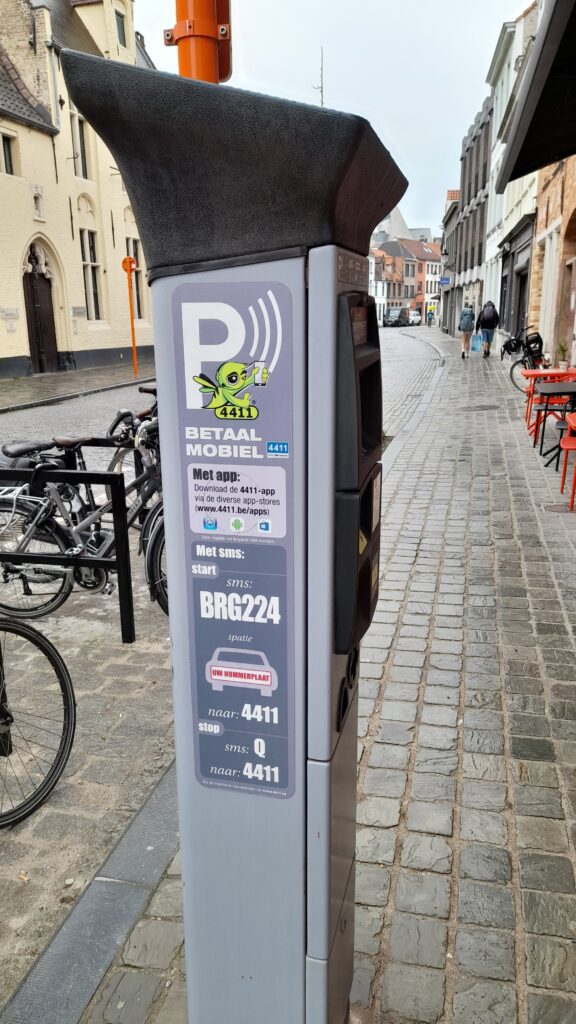

Payment options
When it comes to paying for on-street parking in Bruges, there are several options available. The most common method is to use the parking meters located on the street, which accept credit/debit cards. These meters typically display the time limit for parking in that particular spot, as well as the cost per hour. Another option for paying for on-street parking is through a mobile app, such as 4411 and others (mentioned on the parking meter). This allows you to pay for parking and extend your parking time remotely, eliminating the need to return to the meter to add more time.
It’s important to check the options available in the specific parking zone you will be parked in. Having multiple payment options can make the parking experience more convenient and stress-free.
Above-ground parking in the city center is limited to four hours between the hours of 9.00 and 20.00. There is a charge (€2 for the first hour, €5 for two hours, €9 for three hours and €14 for four hours). You can pay by text message (Belgian phone numbers only), with the 4411 app, or by bank card. Always enter the correct number plate!
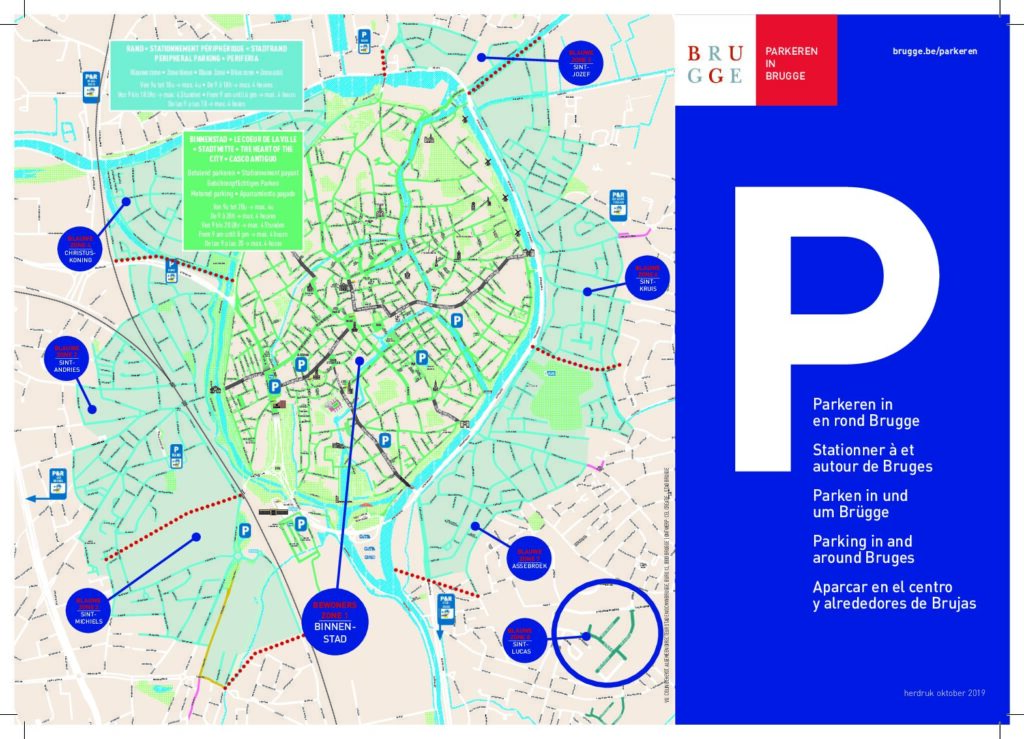

Town outskirts
Blue zone, allowing up to 4 hours’ parking per day, with a valid
European parking disc, every day from 9u to 18u
Underground parking areas in the town centre
- 2.500 parking spaces – max. € 14,40 per 24 h
- opening hours: 24 hours a day
P centrum- Station - 1.500 parking spaces – max. € 5,50 per 24 h; free buses to
and from the town centre - opening hours: 24 hours a day
Free parking areas situated around the town centre - allowing you to walk to the centre or to take a bus
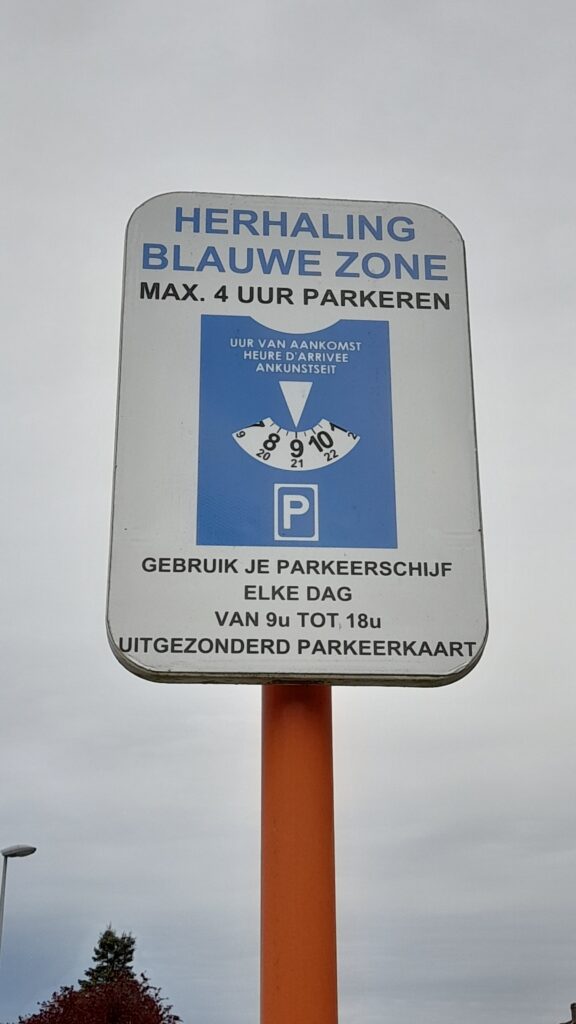

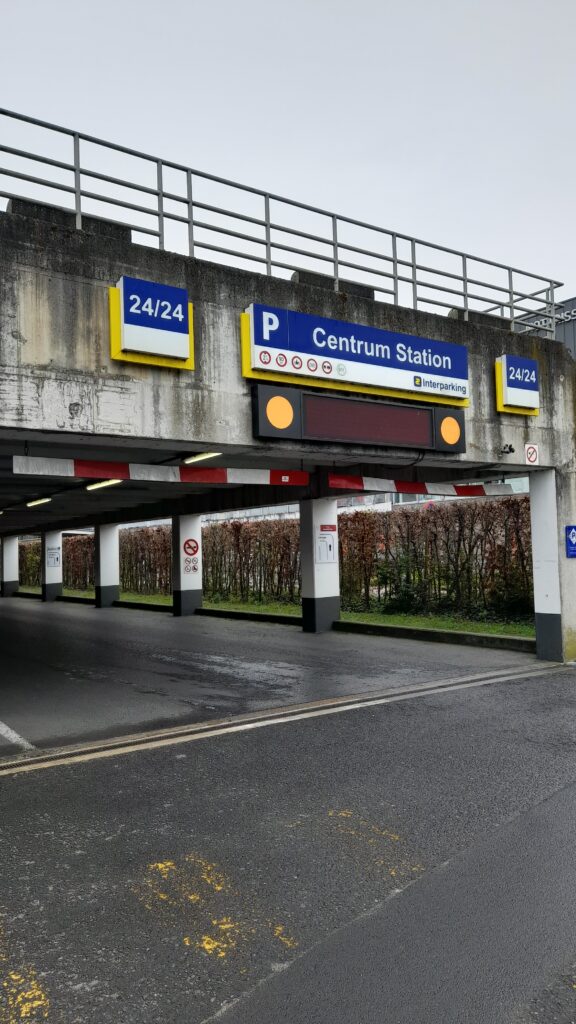

Shop and go
Short-term parking spaces are provided at various locations on the territory of Bruges, both in the city center and in the boroughs. At these locations, you can park for a maximum of 30 minutes at a time.
Off-street parking
Off-street parking in Bruges can be found in the form of parking garages and parking lots. These facilities offer a more secure and sheltered option for parking your car, and can often be more convenient than on-street parking.
One option for off-street parking is parking garages, which are located throughout the city. These garages typically offer hourly and daily rates. Some garages also offer reserved parking spaces, which can be booked in advance. It’s important to note that the prices for parking in a garage can vary depending on the location and the time of day, so it’s a good idea to compare prices and check for discounts or promotions.
Off-street parking is less expensive than on-street parking and offers more protection and security to your car and can be more convenient. It’s important to check the location and prices of the parking garages and lots, and compare them with the on-street parking options to find the best option for your needs and budget.
Check out this website for parking garages in Bruges.
Prices
The prices for parking in the center of Bruges can vary depending on the type of parking, location, and time of day. On-street parking typically ranges from € 2 (60 min.) to €14 for 4 hours.
The prices for off-street parking in garages and lots can also vary, with hourly rates typically ranging from € 0 to €2 and daily rates ranging from €15,80. Monthly and long-term parking rates are also available, which can be more cost effective for those who plan to park in the city for an extended period.
Some garages and lots offer discounts or promotions, so it’s worth checking for these options when looking for parking. Keep in mind that it’s always better to pay for parking rather than risk a fine for parking illegally.
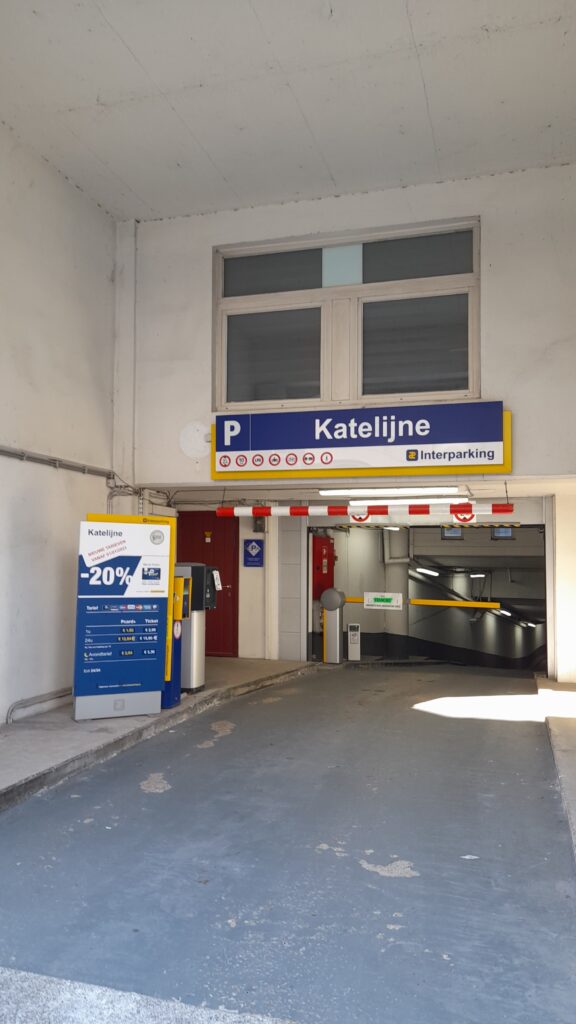

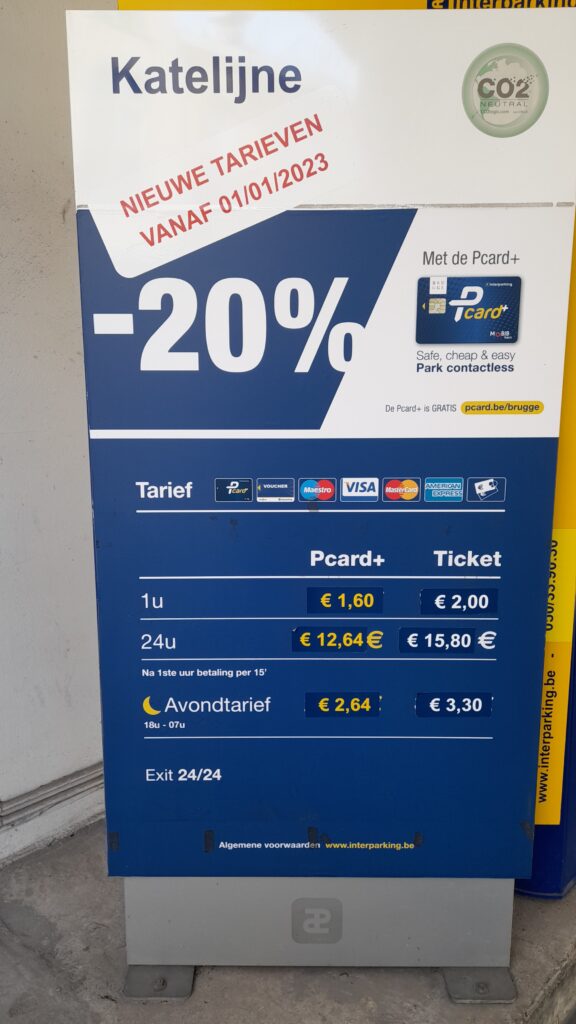

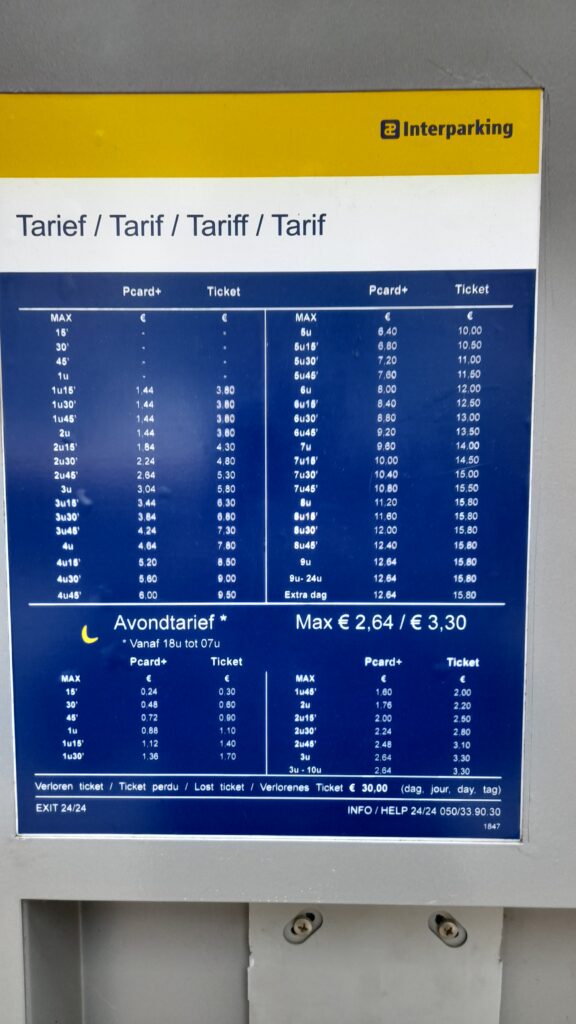

Park and rides
One great option for those looking for parking in Bruges is the “park and ride” system. Park-and-ride facilities are located on the outskirts of the city and provide a convenient and cost-effective option for those who are planning to take public transportation into the city center. The idea behind park and ride is to reduce traffic congestion and air pollution by encouraging the use of public transportation.
The Park and Ride facilities in Bruges offer secure and affordable parking; most are free. Once parked, you can take a Shuttle to the city center, avoiding the hassle of finding parking in the city center.
Every day between 07:20 and 19:00 there is a free shuttle service in Bruges. This Centre Shuttle travels a fixed route every 20 minutes between the Lodewijk Coiseaukaai car park and the Station (Kiss & Ride).
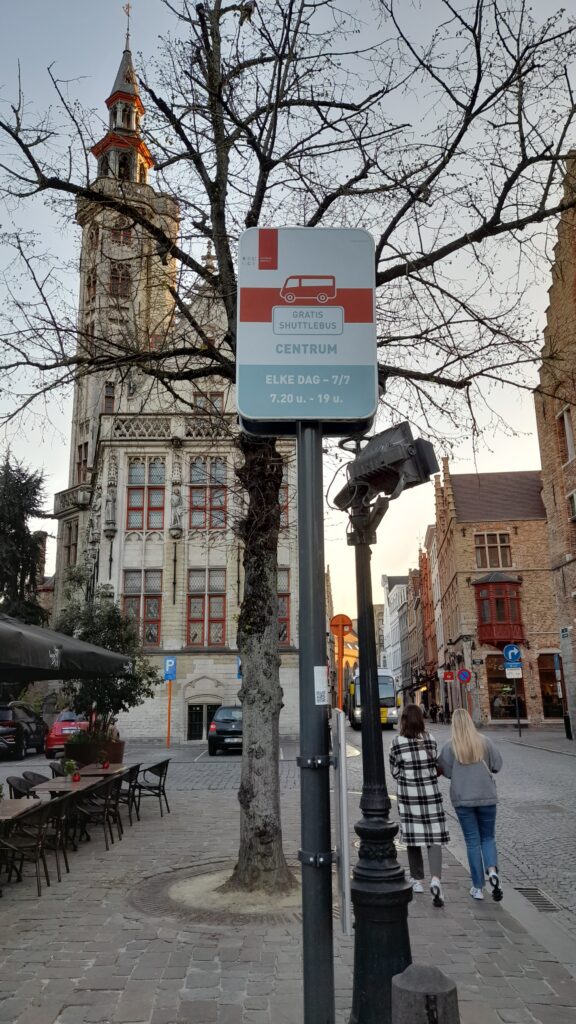

At the park & rides you can also park for free and unlimited and you have the possibility to take public transport to the city center.
You will find park & rides in Sint-Pieters (Waggelwaterstraat – 183 parking spaces), in Steenbrugge (Baron Ruzettelaan – 185 parking spaces), in Sint-Kruis (Boogschutterslaan – 100 parking spaces) and in Sint-Andries (Jan Breydel stadium – 100 parking spaces).
The park-and-ride facilities are strategically located near the major highways and major public transportation routes making it easy to access the city center. It’s a great option for those who are planning to spend the day in the city and want to avoid the stress and expense of finding parking in the city center.
Where can you park for free in Bruges?
There are some areas in Bruges where you can park for free, but keep in mind that they may be a bit far from the city center. Here are some options:
- Park & Ride: You can park your car at one of the P&R sites located around the city, and take a bus or bike into the city center. The P&R sites and shuttle bus are free.
- Residential areas: Some residential areas outside the city center offer free parking. However, be sure to check for any parking restrictions (Blue zone) or time limits before leaving your car there.
How do you pay for parking in Bruges?
In Bruges, there are several options for paying for parking, including:
- Parking meters: These are located on the street and accept credit/debit cards. The parking meter will indicate the cost per hour and the time limit for parking in that spot.
- Mobile app: You can pay for parking using a mobile app such as 4411. This allows you to pay for parking and extend your parking time remotely, eliminating the need to return to the meter to add more time. Other apps are mentioned on the parking meters.
- Paying with sms.
- Cash in parking garages.
It’s important to note that different parking zones may have different payment options available, so it’s best to check the signs or contact the local authorities for more information. Additionally, it’s always a good idea to have coins or a credit card on hand as a backup, in case the preferred payment method is not accepted.
Special parking arrangements
Disabled parking
In Bruges, special arrangements are made for those with disabilities to make parking more accessible. There are designated parking spots for disabled drivers and passengers throughout the city, which are typically located near buildings and other amenities. These spots are marked with the international symbol of accessibility and are usually wider than regular parking spots, making it easier for wheelchair users to get in and out of the car.
To use these spots, drivers must have a valid disabled parking permit, which can be obtained from the local authorities. These permits are usually issued to individuals with a permanent or temporary mobility impairment and allow them to park in designated disabled parking spots in Bruges and other cities in Belgium.
It’s important to note that parking in a disabled spot without a valid permit is illegal and can result in fines.
Disabled parking spots in Bruges provide a convenient and accessible option for those with mobility impairments, and the city makes an effort to ensure that these spots are well-marked and located in convenient locations.
Electric vehicle charging stations
As the use of electric vehicles (EVs) becomes more popular, finding a charging station in Bruges has become an important aspect when it comes to parking. The city offers several EV charging stations throughout the city, which can be found in parking garages, public parking lots, and on the street. These charging stations are usually operated by different companies and networks, so it’s important to check the availability and the cost of the charging service before using it.
The city of Bruges is making an effort to increase the number of EV charging stations to support the growing number of electric vehicles on the road, and it’s an important aspect to consider when it comes to parking in Bruges.
Conclusion
Summary of key points
In conclusion, parking in Bruges can be a bit challenging, but with a little bit of knowledge, it can be a breeze. The city offers a variety of options for parking, including on-street parking, off-street parking, and special arrangements for specific needs such as disabled parking and electric vehicle charging stations.
On-street parking is regulated and restricted in certain areas and requires payment, usually through a zone system. It’s important to pay attention to the signs and parking meters in each zone and be aware of the regulations and restrictions that apply in that area. Off-street parking is available in the form of parking garages and lots, with varying locations, prices, and reservation options.
Parking prices can vary depending on the type of parking, location, and time of day, so it’s important to check and compare prices before making a decision. Additionally, some garages and lots offer discounts or promotions, such as early bird or night rates.
Special arrangements are made for those with disabilities to make parking more accessible, with designated parking spots for disabled drivers and passengers throughout the city. EV owners should also keep in mind the availability and cost of EV charging stations when parking in Bruges.
In summary, the key points to consider when parking in Bruges are: the regulations and restrictions of the parking zone, the payment options, the location and prices of the parking garages and lots, the special arrangements for disabled parking, and the availability and cost of EV charging stations. With this knowledge, you will be able to find the best parking option that suits your needs and budget, making your trip to Bruges stress-free and enjoyable.
Additional resources for finding parking in Bruges.
In addition to the information provided in this guide, there are several other resources available for finding parking in Bruges. One useful resource is the website of the city of Bruges, which provides up-to-date information on parking regulations, restrictions, and locations of parking garages and lots. The website also provides information on disabled parking, electric vehicle charging stations.
Another useful resource is online parking guides such as Google Maps, which provide detailed information on parking options, prices, and real-time availability in various locations throughout the city. These apps can be used to find the nearest parking spot and also to compare prices and check for discounts or promotions.
more detailed info?
People also read:
Is time too short to see everything in Bruges? book your hotel stay here and discover more about Bruges.
Spend the night in Bruges
Booking.combook a tour
More usefull information and links
Get more out of your visit by searching and exploring the following information and website links
- Belfry of Bruges (Belfort)
- Grand Place (Grote Markt)
- Bruges Canal Boat Tours
- Markt Square (Markt)
- Church of Our Lady (Onze-Lieve-Vrouwekerk)
- Bruges City Hall (Stadhuis)
- Groeningemuseum
- Burg Square (Burg)
- The Beguinage (Begijnhof)
- Bruges Museum – Historium
- Choco-Story Bruges
- The Frietmuseum
- The Medieval Torture Museum
- Bruges Windmills
- Sint-Salvators Cathedral
- The Belgian Beer Museum
- Minnewater Lake (Lake of Love)
- Arentshuis Museum
- Diamantmuseum Bruges
- Brouwerij De Halve Maan (Half Moon Brewery)
- Torture Museum
- Bruges Art Museum
- Museum of the Holy Blood (Heilig-Bloedbasiliek)
- Ezelpoort (Donkey Gate)
- Hansa Brewery
- Loppem Castle (Kasteel Loppem)
- Historium Bruges
- Bruges Diamond Museum
- Kruispoort (Cross Gate)
- Museum of Musical Instruments
- Parking in Bruges
- Q-Park Bruges
- Interparking Bruges
- Parking in Bruges City Center
- Park and Ride Bruges
- Bruges Parking Zones and Rates
- Underground Parking in Bruges
- Parking near Bruges Station
- B-Parking Bruges
- Public Parking Information in Bruges
These links will help visitors find detailed information on parking options and regulations in Bruges.
FAQ
written by Johnny
This article may contain affiliate links. This means that we receive a small commission when you book something via these links. Of course, this does not cost you anything extra. Did our tips help you? We would love it if you book your trip via the links in the article above. Thank you so much.
Read more articles on my Bruges page.